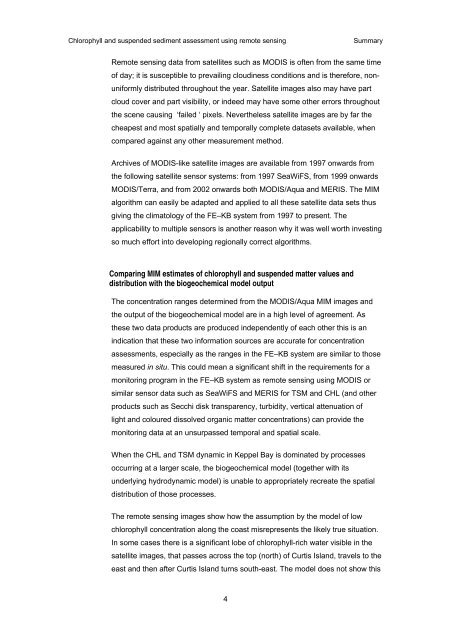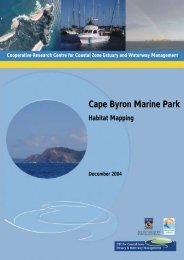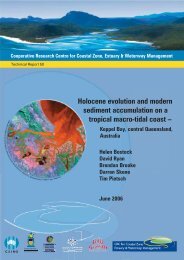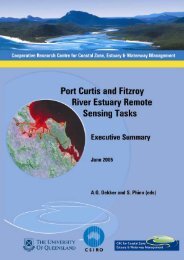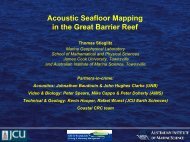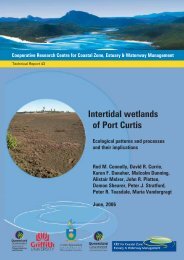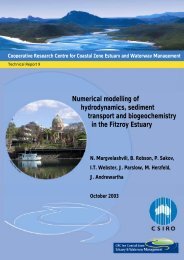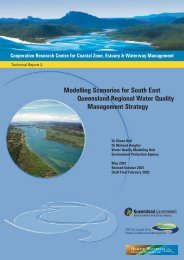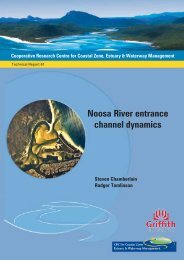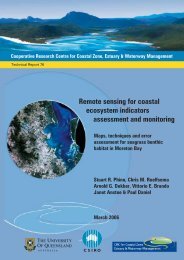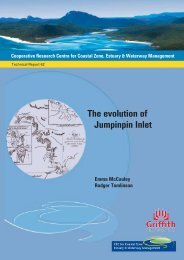Chlorophyll and suspended sediment assessment in a ... - OzCoasts
Chlorophyll and suspended sediment assessment in a ... - OzCoasts
Chlorophyll and suspended sediment assessment in a ... - OzCoasts
Create successful ePaper yourself
Turn your PDF publications into a flip-book with our unique Google optimized e-Paper software.
<strong>Chlorophyll</strong> <strong>and</strong> <strong>suspended</strong> <strong>sediment</strong> <strong>assessment</strong> us<strong>in</strong>g remote sens<strong>in</strong>gSummaryRemote sens<strong>in</strong>g data from satellites such as MODIS is often from the same timeof day; it is susceptible to prevail<strong>in</strong>g cloud<strong>in</strong>ess conditions <strong>and</strong> is therefore, nonuniformlydistributed throughout the year. Satellite images also may have partcloud cover <strong>and</strong> part visibility, or <strong>in</strong>deed may have some other errors throughoutthe scene caus<strong>in</strong>g ‘failed ‘ pixels. Nevertheless satellite images are by far thecheapest <strong>and</strong> most spatially <strong>and</strong> temporally complete datasets available, whencompared aga<strong>in</strong>st any other measurement method.Archives of MODIS-like satellite images are available from 1997 onwards fromthe follow<strong>in</strong>g satellite sensor systems: from 1997 SeaWiFS, from 1999 onwardsMODIS/Terra, <strong>and</strong> from 2002 onwards both MODIS/Aqua <strong>and</strong> MERIS. The MIMalgorithm can easily be adapted <strong>and</strong> applied to all these satellite data sets thusgiv<strong>in</strong>g the climatology of the FE–KB system from 1997 to present. Theapplicability to multiple sensors is another reason why it was well worth <strong>in</strong>vest<strong>in</strong>gso much effort <strong>in</strong>to develop<strong>in</strong>g regionally correct algorithms.Compar<strong>in</strong>g MIM estimates of chlorophyll <strong>and</strong> <strong>suspended</strong> matter values <strong>and</strong>distribution with the biogeochemical model outputThe concentration ranges determ<strong>in</strong>ed from the MODIS/Aqua MIM images <strong>and</strong>the output of the biogeochemical model are <strong>in</strong> a high level of agreement. Asthese two data products are produced <strong>in</strong>dependently of each other this is an<strong>in</strong>dication that these two <strong>in</strong>formation sources are accurate for concentration<strong>assessment</strong>s, especially as the ranges <strong>in</strong> the FE–KB system are similar to thosemeasured <strong>in</strong> situ. This could mean a significant shift <strong>in</strong> the requirements for amonitor<strong>in</strong>g program <strong>in</strong> the FE–KB system as remote sens<strong>in</strong>g us<strong>in</strong>g MODIS orsimilar sensor data such as SeaWiFS <strong>and</strong> MERIS for TSM <strong>and</strong> CHL (<strong>and</strong> otherproducts such as Secchi disk transparency, turbidity, vertical attenuation oflight <strong>and</strong> coloured dissolved organic matter concentrations) can provide themonitor<strong>in</strong>g data at an unsurpassed temporal <strong>and</strong> spatial scale.When the CHL <strong>and</strong> TSM dynamic <strong>in</strong> Keppel Bay is dom<strong>in</strong>ated by processesoccurr<strong>in</strong>g at a larger scale, the biogeochemical model (together with itsunderly<strong>in</strong>g hydrodynamic model) is unable to appropriately recreate the spatialdistribution of those processes.The remote sens<strong>in</strong>g images show how the assumption by the model of lowchlorophyll concentration along the coast misrepresents the likely true situation.In some cases there is a significant lobe of chlorophyll-rich water visible <strong>in</strong> thesatellite images, that passes across the top (north) of Curtis Isl<strong>and</strong>, travels to theeast <strong>and</strong> then after Curtis Isl<strong>and</strong> turns south-east. The model does not show this4


